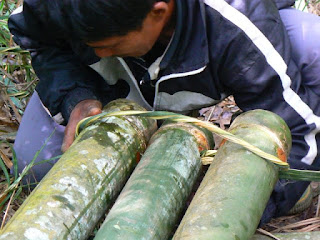The Lahu are comfortable in the Forest
See the radio the little guy is carrying? I bought the same radio down at the market for eighty thousand kip. AM/FM and a whole lota short wave. They were tuned to Thai pop, happy and walking along.
We passed them earlier at the place they slept and now they were passing us at our break. We were to pass them again but still they made it to Nambo that same day, saw them rolling in around sunset. Not a bad walk for such a little guy.
They slept in what you see in the photo. They'd propped some sticks up and covered them with banana leaves and also the sides, the front open to the fire. The leaves overhead served two purposes, to reduce the radiant heat loss to the sky and to reflect some of the heat of the fire back down onto their bodies. The husband and wife slept on the outside curled around the children who slept sound and warm in the middle. The husband slept in a T-shirt only, his back must have been cold.
The nights at that elevation are chilly, the dew heavy.
Rice had been cooked the night before by putting it and some water inside a green section of bamboo and cooking it on the fire. They were eating left overs for breakfast. They drank from the spring.
They were coming from town, a shopping trip. They brought with them a knife and some rice.
ສມົຊາຍ


























